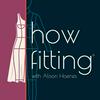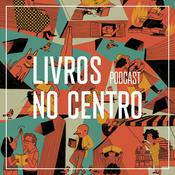128 episódios

Why This Brand Launched Without Social Media and What They Did Instead with Maria Alejandra Alvarado of ZADIMA
18/11/2025 | 58min
Changing algorithms, the constant time investment, and, with the rise of AI, even more content to compete with for customers’ attention make many of us want to avoid social media altogether. However, it can seem like a necessary evil. Isn’t every brand on social platforms? But what if staying off socials as a fashion brand isn’t just the right choice for your mental health as a founder, but also for your business strategy? This is the choice that Maria Alejandra Alvarado has made for her luxury workwear brand ZADIMA. In episode 127, she shares how she’s connecting with people to market her brand instead of competing with algorithms. For Maria, it felt like a natural fit that aligns with her business. María Alejandra Alvarado is a marketing leader with nearly 15 years of experience shaping brand and product launch strategies for global companies. For the past three years, she’s been building ZADIMA — a brand born from her desire to help modern professionals dress beautifully and intentionally, without adding more decisions to already full days. Frustrated by the lack of color, personality, and quality in workwear, María set out to create pieces that combine great tailoring, elegant silhouettes, and luxurious Italian fabrics. Each garment is crafted from exquisite Italian deadstock textiles in a woman-owned atelier in Manhattan’s Garment District, designed to make women feel confident, polished, and effortlessly themselves. This episode explores: Fitting the customer The smart questions Maria asked while gathering customer research The ways that knowing her customer helped Maria make decisions about fabric, designs, and colors Fitting the lifestyle How the lifestyle of the Zadima customer shaped the marketing strategy The practical ways Maria generates word-of-mouth referrals How Maria represents her brand as the founder How Maria prioritizes tasks in her business Fitting the values Why Maria decided to produce her collection in NY How Maria uses AI tools in alignment with her relationships and quality-focused business values People and resources mentioned in this episode: ZADIMA website ZADIMA email Maria’s LinkedIn Do you want fashion business tips and resources like this sent straight to your inbox? Sign up for the How Fitting newsletter to receive new podcast episodes plus daily content on creating fashion that fits your customer, lifestyle, and values.

Intentional Fashion Looks Different as a Founder with Lucielle Salomon of ARIMMA
04/11/2025 | 54min
In slow fashion, we like being intentional with our clothing choices. We want our wardrobes to be aligned with what we care about and how we live. It is a reassuring kind of intention. Then there is another type of intention that affects fashion founders – the way we intend things to go. We have intentions for the launch, product development timelines, or what it means to be a good founder. But as anyone who has started a business knows, things don’t always go quite as intended. So how do we balance intention and reality? In episode 126, ARIMMA founder Lucielle Salomon shares how she moved past her assumptions about what it means to be a founder and finally launched her brand. Through the process, she now sees fashion in a new light. Lucielle Salomon is a Dominican-American founder, fashion editor and storyteller advocating for a slower, more soulful approach to style and business. With a background in journalism and a sharp editorial eye, she blends thoughtful design with meaningful storytelling, inviting her audience to dress with intention, find beauty in the everyday and redefine what success looks like through a values-first lens. She is the founder of ARIMMA, an on-demand women's wear brand rooted in romantic silhouettes, timeless details and environmental responsibility. Every piece is crafted only after it's ordered—minimizing waste, reducing overproduction and creating space for clothing to be made with care. ARIMMA designs use natural or low-impact materials and are constructed with durability, emotion and longevity in mind. Through her Substack newsletter, Woven Letters, and growing digital platforms, Lucielle shares a curated blend of sustainable fashion finds, emerging brands, and everyday rituals—from what she's wearing to how she's slowing down. As a mother of two, she also explores the intersection of creativity, motherhood and entrepreneurship, offering a rare behind-the-scenes look at building a conscious business without burning out. Lucielle is available for interviews, panels, collaborations, and essays that explore the future of fashion, identity-driven entrepreneurship and intentional living. This episode explores: Fitting the customer How Lucielle follows feelings, not trends with her designs The part of development that was the biggest challenge for Lucielle Fitting the lifestyle What Lucielle would do differently now if she was starting over How our mindset can hinder or help us in entrepreneurship What Lucielle thought a good founder lifestyle should look like and why that didn’t work for her Why Lucielle didn’t go all out for the launch Fitting the values How becoming a founder changed what Lucielle values about fashion Why Lucielle reached out to factories before she even had designs People and resources mentioned in this episode: Arimma website Arimma Instagram Lucielle’s Instagram Do you want fashion business tips and resources like this sent straight to your inbox? Sign up for the How Fitting newsletter to receive new podcast episodes plus daily content on creating fashion that fits your customer, lifestyle, and values.

Consistency or Newness: What It Takes To Get To A Decade In Fashion Business with Erin Gray Morton of erin gray
21/10/2025 | 1h
Newness builds excitement, but consistency builds trust. Which one will get your brand to a decade in business? Erin Gray Morton just celebrated ten years of her gold-filled jewelry and premium tee shirt line erin gray. The brand has grown to being stocked in over 800 boutiques. To get there, Erin and her team have prioritized relationships while figuring out how to make each wholesale show feel new with basics products that are more timeless than trendy. In episode 125, hear the ways erin gray builds trust with customers and the boutiques that buy wholesale from them, how Erin keeps herself from a lifestyle of overworking even when she loves what she does, and how Erin structured the business model and pricing from the very beginning to allow giving back to causes she values. erin gray is a female-owned and operated brand from Atlanta designing elevated essentials with a touch of luxury. Their customers primarily love them for two things: their cult-favorite Pima cotton tees and refined tops that offer high-end style at accessible prices and our 14k gold-filled waterproof jewelry, which wears like solid gold without the high cost. Erin built this brand from the ground up and the brand is now featured in more than 800 boutiques nationwide. Giving back is our heart - Erin lost her mother to cancer, so supporting cancer research is at the core. The atmosphere at erin gray's Atlanta warehouse is fun, respectful, flexible, family-oriented and customer-focused. The team gets things done without compromising the things and people who matter to them the most. This episode explores: Fitting the customer The ways erin gray builds trust with customers and the boutiques that buy wholesale from them The effort that went into developing the best basic white tee (because simple is never simple!) How erin gray creates newness at each wholesale market with a basic, timeless product Why Erin thinks wholesale shows will never go away Fitting the lifestyle What they did differently when erin gray introduced apparel alongside their jewelry line How Erin keeps herself from overworking even when she loves what she does How Erin has expanded her team over the years The benefits of a long wholesale design and development calendar What to do when you get bored of your product before it even launches Fitting the values How Erin structured the business model and pricing from the very beginning to allow giving back to causes she values Ways your business can give back to causes you care about beyond cash donations Why customer service is so important for the success of erin gray People and resources mentioned in this episode: Erin Gray website Erin Gray email Erin Gray Instagram Erin’s LinkedIn Do you want fashion business tips and resources like this sent straight to your inbox? Sign up for the How Fitting newsletter to receive new podcast episodes plus daily content on creating fashion that fits your customer, lifestyle, and values.

Listening to Your Body in Entrepreneurship and Fashion with Victoria Lister of Hummingbird Pie
07/10/2025 | 57min
In an industry obsessed with outward appearances, what if we made decisions by listening to our body and not just looking at it? If clothing choices came from a place of self-awareness, how would that change the way we design products and run fashion businesses? Victoria Lister approaches her work from this perspective. In episode 124, she shares what made her start listening to her body and what that has meant for her underwear and lounge brand Hummingbird Pie. Victoria is the founder and owner-operator of Hummingbird Pie, an Australian-based, micro-business that has supplied women with luxe, everyday basics since 2015. The business was born from Victoria's personal quest to solve the problem of thigh chafing without resorting to shapewear – a challenge that led her to create Hummingbird Pie’s flagship product, long-legged underpants known as ‘Longerpants’. Today, the range has expanded to include outer as well as underwear, designed to help women of all ages, stages, shapes and sizes to feel at home in themselves – not reshaped, but supported, relaxed and free to be. Hummingbird Pie fits in and around Victoria's work as a researcher, with the help of her wonderful husband and two dear friends who work casually on different aspects of business, and local suppliers and manufacturers. This episode explores: Fitting the customer How the Hummingbird Pie target customer has expanded since the start of the business The mindset that unites Hummingbird Pie customers What makes Hummingbird Pie garments different The relationship Victoria wants her customers to have with Hummingbird Pie clothes Fitting the lifestyle The challenges of scaling a cottage business Why new products don’t always start with design What gave Victoria the courage to start a business The behind the scenes lifestyle that supports Victoria’s business Fitting the values How Victoria’s self-awareness and valuing her body influences her approach to design Why Victoria prefers working with other collaborators instead of learning how to do everything herself People and resources mentioned in this episode: Hummingbird Pie website Hummingbird Pie email Hummingbird Pie Instagram Victoria’s LinkedIn Do you want fashion business tips and resources like this sent straight to your inbox? Sign up for the How Fitting newsletter to receive new podcast episodes plus daily content on creating fashion that fits your customer, lifestyle, and values.

The Time And Resilience It Takes To Launch A Fashion Brand with Gabriela Garcia Olivo of Gabriela Michele
23/9/2025 | 55min
We talk about how timeless fashion lets us build sustainable wardrobes. What if the benefits of timelessness weren’t confined to our customers’ closets? Today’s guest, Gabriela Garcia Olivo, found that her timeless designs helped her build a more sustainable business. Her story is one of resilience, refinement, and reflection. In episode 123, she shares her perspective on what it takes and why it is worth it to build a fashion brand. Gabriela Garcia Olivo is the founder and creative director of Gabriela Michele, a timeless women’s clothing brand inspired by the elegance of 1950s fashion and the captivating spirit of Latin American women. Born from a desire to celebrate feminine sophistication in everyday life, her brand merges vintage glamour with modern craftsmanship. With a commitment to quality, her collections feature natural fabrics, tailored fits, and thoughtful details that invite women to embrace their confidence and femininity. This episode explores: Fitting the customer Why Gabriela does not use herself as the fit model even though she is her target market The surprising demographic of women who resonate with her brand The two things that have made the biggest difference in finding her customers and growing the brand Fitting the lifestyle How long it took from idea to launch The aspects of vintage style that Gabriela has carried into her designs Why Gabriela paused her brand twice since initially launching What kept Gabriela going when sales were slow and burnout was looming How Gabriela balances ambition with realistic expectations for her business Fitting the values How Gabriela found a factory and patternmaker that she trusts How timeless style has led to a timeless business People and resources mentioned in this episode: Gabriela Michele website Gabriela Michele Instagram Gabriela Michele email Do you want fashion business tips and resources like this sent straight to your inbox? Sign up for the How Fitting newsletter to receive new podcast episodes plus daily content on creating fashion that fits your customer, lifestyle, and values.
Mais podcasts de Arte
Podcasts em tendência em Arte
Sobre How Fitting: design a slow fashion business that fits
Ouça How Fitting: design a slow fashion business that fits, Rádio Companhia e muitos outros podcasts de todo o mundo com o aplicativo o radio.net

Obtenha o aplicativo gratuito radio.net
- Guardar rádios e podcasts favoritos
- Transmissão via Wi-Fi ou Bluetooth
- Carplay & Android Audo compatìvel
- E ainda mais funções
Obtenha o aplicativo gratuito radio.net
- Guardar rádios e podcasts favoritos
- Transmissão via Wi-Fi ou Bluetooth
- Carplay & Android Audo compatìvel
- E ainda mais funções


How Fitting: design a slow fashion business that fits
baixe o aplicativo,
ouça.






























